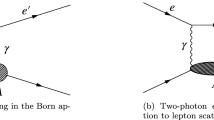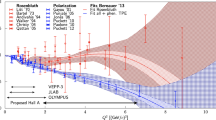Abstract
Two-photon exchange and the larger class of hadronic box diagrams are difficult to calculate without a large degree of model-dependence. At the same time, these processes are significant radiative corrections in parity-violating electron scattering, in neutron decay, and may even be responsible for the proton’s form factor ratio discrepancy. New kinds of experimental data are needed to help constrain models and guide future box-diagram calculations. The target-normal single spin asymmetry, \(A_n\), formed with an unpolarized beam scattering from a target that is polarized normal to the scattering plane, is sensitive to the imaginary part of the two-photon exchange amplitude, and can provide a valuable constraint. A measurement with both electrons and positrons can reduce sources of experimental error, and distinguish between the effects of two-photon exchange and those of time-reversal symmetry violation. This article describes a proposed experiment in Hall A, using the new Super Big-Bite Spectrometer that can cover a momentum transfer range in the critical zone of uncertainty between where hadronic calculations and those based on partonic degrees of freedom are expected to be accurate.




Similar content being viewed by others
Data Availability Statement
This manuscript has no associated data or the data will not be deposited. [Authors’ comment: We describe a possible future experiment, and so there is no data to deposit.]
References
P.A.M. Guichon, M. Vanderhaeghen, Phys. Rev. Lett. 91, 142303 (2003). https://doi.org/10.1103/PhysRevLett.91.142303
P.G. Blunden, W. Melnitchouk, J.A. Tjon, Phys. Rev. Lett. 91, 142304 (2003). https://doi.org/10.1103/PhysRevLett.91.142304
C.E. Carlson, M. Vanderhaeghen, Ann. Rev. Nucl. Part. Sci. 57, 171 (2007). https://doi.org/10.1146/annurev.nucl.57.090506.123116
N. Christ, T.D. Lee, Phys. Rev. 143, 1310 (1966). https://doi.org/10.1103/PhysRev.143.1310
V. Glaser, B. Jaksic, Nuovo Cim. 5, 1197 (1957)
D. Schildknecht, Z Phys. 201, 99 (1967)
J. Bernstein, G. Feinberg, T.D. Lee, Phys. Rev. 139, B1650 (1965). https://doi.org/10.1103/PhysRev.139.B1650
O. Tomalak, M. Vanderhaeghen, Eur. Phys. J. A 51(2), 24 (2015). https://doi.org/10.1140/epja/i2015-15024-1
P.G. Blunden, W. Melnitchouk, Phys. Rev. C 95(6), 065209 (2017). https://doi.org/10.1103/PhysRevC.95.065209
J. Ahmed, P.G. Blunden, W. Melnitchouk, Phys. Rev. C 102(4), 045205 (2020). https://doi.org/10.1103/PhysRevC.102.045205
Y. Chen, A. Afanasev, S. Brodsky, C. Carlson, M. Vanderhaeghen, Phys. Rev. Lett. 93, 122301 (2004). https://doi.org/10.1103/PhysRevLett.93.122301
A.V. Afanasev, S.J. Brodsky, C.E. Carlson, Y.C. Chen, M. Vanderhaeghen, Phys. Rev. D 72, 013008 (2005). https://doi.org/10.1103/PhysRevD.72.013008
N. Kivel, M. Vanderhaeghen, Phys. Rev. Lett. 103, 092004 (2009). https://doi.org/10.1103/PhysRevLett.103.092004
T. Powell et al., Phys. Rev. Lett. 24, 753 (1970). https://doi.org/10.1103/PhysRevLett.24.753
G.V. Di Giorgio et al., Nuovo Cim. 39, 474 (1965)
J.C. Bizot, J.M. Buon, J. Lefrançois, J. Perez-y Jorba, P. Roy, Phys. Rev. 140, B1387 (1965). https://doi.org/10.1103/PhysRev.140.B1387. https://link.aps.org/doi/10.1103/PhysRev.140.B1387
R. Prepost, R.M. Simonds, B.H. Wiik, Phys. Rev. Lett. 21(17), 1271 (1968). https://doi.org/10.1103/PhysRevLett.21.1271
J.R. Chen et al., Phys. Rev. Lett. 21, 1279 (1968). https://doi.org/10.1103/PhysRevLett.21.1279
J.A. Appel et al., Phys. Rev. D 1, 1285 (1970). https://doi.org/10.1103/PhysRevD.1.1285
S. Rock et al., Phys. Rev. Lett. 24, 748 (1970). https://doi.org/10.1103/PhysRevLett.24.748
A. Airapetian et al., Phys. Lett. B 682, 351 (2010). https://doi.org/10.1016/j.physletb.2009.11.041
J. Katich et al., Phys. Rev. Lett. 113(2), 022502 (2014). https://doi.org/10.1103/PhysRevLett.113.022502
Y.W. Zhang et al., Phys. Rev. Lett. 115(17), 172502 (2015). https://doi.org/10.1103/PhysRevLett.115.172502
E. Long et al., Phys. Lett. B 797, 134875 (2019). https://doi.org/10.1016/j.physletb.2019.134875
A. Schmidt, A.I.P. Conf, AIP Conf. Proc. 1970(1), 020006 (2018). https://doi.org/10.1063/1.5040200
C.W. de Jager et al., The Super-Bigbite Spectrometer for Jefferson Lab Hall A (Tech. rep, Jefferson Lab Conceptual Design Report, 2009)
B. Wojtsekhowski, et al., Jefferson Lab E12-09-018 (2011)
J. Alcorn et al., Nucl. Instrum. Method A 522, 294 (2004). https://doi.org/10.1016/j.nima.2003.11.415
V.D. Burkert et al., Nucl. Instrum. Meth. A 959, 163419 (2020). https://doi.org/10.1016/j.nima.2020.163419
T. Averett et al., Nucl. Instrum. Method A 427, 440 (1999). https://doi.org/10.1016/S0168-9002(98)01431-4
C. Keith et al., Nucl. Instrum. Method A 501, 327 (2003). https://doi.org/10.1016/S0168-9002(03)00429-7
C. Keith, J. Brock, C. Carlin, S. Comer, D. Kashy, J. McAndrew, D. Meekins, E. Pasyuk, J. Pierce, M. Seely, Nucl. Instrum. Method A 684, 27 (2012). https://doi.org/10.1016/j.nima.2012.04.067
J. Pierce et al., Phys. Part. Nucl. 45, 303 (2014). https://doi.org/10.1134/S1063779614010808
B. Wojtsekhowski, et al., Jefferson Lab E12-09-019 (2009)
B. Wojtsekhowski, et al., Jefferson Lab E12-09-016 (2009)
J.R.M. Annand, et al., Jefferson Lab E12-17-004 (2017)
E. Cisbani, M.K. Jones, N. Liyanage, L.P. Pentchev, A.J.R. Puckett, B. Wojtsekhowski, et al., Jefferson Lab E12-07-109 (2008)
M.K. Jones et al., Phys. Rev. C 74, 035201 (2006). https://doi.org/10.1103/PhysRevC.74.035201
R. Zielinski, The g2p experiment: a measurement of the Proton’s spin structure functions. Ph.D. thesis, New Hampshire U (2010)
Acknowledgements
We thank J. D. Maxwell of the Jefferson Lab target group for helpful discussions about working with transversely polarized targets.
Author information
Authors and Affiliations
Corresponding author
Additional information
Communicated by Nicolas Alamanos
Rights and permissions
About this article
Cite this article
Grauvogel, G.N., Kutz, T. & Schmidt, A. Target-normal single spin asymmetries measured with positrons. Eur. Phys. J. A 57, 213 (2021). https://doi.org/10.1140/epja/s10050-021-00531-7
Received:
Accepted:
Published:
DOI: https://doi.org/10.1140/epja/s10050-021-00531-7




